|
|
|
Road Testing the Autocom Active-7-Smart Motorcycle Communications System
|
| Nightrider Recommended The Autocom Active-7 is an excellent product that adds a new dimension to the riding experience. Bike-to-bike, cell phone, music, radar detector and GPS connections are all possible. Testing on our ZZR-1200 sport touring bike and HD Super Glide was uneventful, meeting all our expectations. While a Harley-Davidson FXDL with a mostly streetable race engine provided more of a challenge, the Active-7 came through in fine shape after installing the wind sock kit on the microphone. The Autocom electronics proved that it works in very high noise environments. We wish that Autocom had included the Wind Sock kit as part of the standard package. This would have eliminated the initial issues encountered with the noisy FXDL. |
For years touring bikes have had FM radios for the enjoyment of rider/passenger and CB radios for communications between bikes as part of the OEM package, as an add-on from the factory or an after market unit. If you had a sport bike or cruiser, little was available to provide the same bike-to-bike communication or the ability to listen to music while riding. And those systems that were available did not always provide reliable communication or decent quality of sound. Many of the bike-to-bike communication system relied on PTT (push-to-talk) switches because VOX (voice actuated operation) was easily triggered by wind or engine noises. But PTT can add a lot of additional wiring to the bike and could be inconvenient to use. VOX was usually preferred, but was generally unreliable especially as speed increased. Quality of sound was generally very poor. Many touring bikes use fairing mounted speakers which rapidly become useless as speed increases. Ear phones could be difficult to put in your ears, decrease ability to hear surrounding traffic sounds and were uncomfortable to wear.
Yet few riders would disagree that the ability to listening to music and/or talk with other riders is very desirable, improving the two-wheeled experience. There just wasn't much available in the commercial market for motorcycles and motor sport specific communication equipment for use in helmets was very expensive.
The Need Arises
My wife has never gotten completely comfortable with our use of hand signals
when we rode together. While she is an excellent rider in her own right, she
wanted much better communications on our rides. With our primary vehicles being
a pair of Harley's, it was well established that VOX units are easily fooled by
the noises from the V-twin engine. After years of trying various (CB/FRS/GMRS)
radios, inexpensive headsets, several different VOX solutions provided by radio
manufacturers and the inability to afford very expensive equipment from the
motor sport communications companies, it was time to try something different. We
decided the claim by Autocom of "Any bike, Any speed" was something
that should be tested. From research and reviews by commercial magazines, I
established that Autocom had an excellent reputation. When I found out that
these units were available for 50% discount for a limited time, it was time to
acquire a set and put them to the ultimate test. We would try to get reliable
bike-to-bike communications between a pair of Harley's with their very robust
exhaust notes.
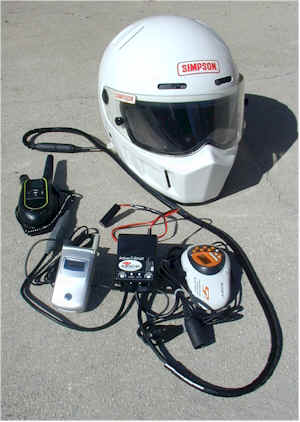 Here is the Autocom "Active-7 Smart" along with the components that it can use. From left to right you will see a GMRS/FRS radio, cell phone, Active-7 system and an FM radio as a music source. In the background you'll see the helmet connection. The only connection not used and tested was the rider-to-passenger cable. As you can see, the Active-7 is only slightly larger than a flip-top cell phone. Radios and cell phones other than those shown here can be used. Your source of music could just as easily be an MP3 or CD player. The Autocom is very flexible to the types of devices that can be connected to it. |
A quick visit to the Autocom WEB site located my local Dealer. This Dealer had both the Pro and Active-7 units in stock. Given the option of saving $100 on the pair by getting the Active-7 over the Pro unit, I purchased the lower cost model and headed home. The Autocom Active-7 units selected have the following capabilities:
| Bike-to-Bike capabilities using 2-way radio connections compatible with CB, FRS, GMRS, VHF and UHF radios | |
| Rider-to-Passenger Intercom | |
| Cell phone connection | |
| Stereo audio input for Radio, CD, MP3, radar detector, GPS |
The Autocom kit included the Active-7 unit, helmet mount speakers, boom microphone, helmet extension cable, cell phone cable and generic audio cable. Because of the number of different connectors for two-way radios, this cable needs to be ordered for your specific type of radio. You would need to order another set of helmet speakers and microphone if you want passenger intercom capabilities.
Installation
While the Autocom Pro-7 unit can be used with internal or external power,
the Active-7 unit does not have internal battery power creating the need to wire
these units to the motorcycle. With 3 motorcycles and two Active-7 units, it
would be nice to be able to use these units between bikes. On the way home I
stopped by a local Radio Shack to pick up some "M" Coaxial power
connectors to make some quick power disconnects. This is a standard size power
connector of the type seen on most electronic equipment today. These $3
connectors would allow the quick movement of the units between bikes. As an
additional benefit, I'd be able to use the Autocom units in automobiles at SCCA
Solo II and drag racing events though a 12V power outlet adapter (a cigarette
lighter plug in the cars).
It took little time to install the two included speakers and boom microphone in my Shoei helmet. Instructions from Autocom were easy to follow and allowed me to place the speakers/mike correctly the first time. I tested everything by putting a set of alligator clips to the power wires from the Autocom unit and connected them to a spare 12V battery I had. I left the Volume and VOX settings in the original settings. As soon as the helmet was connected to the Autocom with its very robust and easy-to-line-up connector, I was able to hear myself speaking. At least I knew the unit was working. I connected in my cell phone and had my wife call me. With the phone set on auto answer, it picked up immediately and I had a crystal clear conversation with her. Our static testing was a success.
Let the real testing begin
I wired the coax power connector into the tail light circuit of my ZZR-1200
to make sure the unit would only activate when the ignition switch was on. I
placed the Autocom unit and cell phone under the seat, connected power and ran
the cable to the helmet connector out the front of the seat, then took a ride.
Again I had my wife call my cell phone at speeds up to 80MPH. In each case, the
communications was crystal clear at both ends.
It was time for the acid test; making sure that the units would work on a noisy Harley. After installing the speakers/microphone in a Simpson helmet and wiring the second unit up on my wife's FXD under the seat, we took a little ride. Because we were still testing with cell phones, a phone call was initiated from one cell phone to the other. The second phone picked up immediately and we were talking with no problem. No static, no wind noise and no loud potato-potato throb coming through in the sound. Absolutely amazing. Of course this was sitting still. I quickly realized that the VOX setting on the HD was a little low because the mike could be triggered by rapping the throttle. A quick change to the VOX setting and the problem was solved. A 45 minute ride at legal speeds yielded perfect communications between the two bikes. Not one single missed word. Static communication testing on our second Harley was just as successful as on the other two bikes.
The Good
At this point I must admit that I'm actually getting quite impressed with
the capabilities of the Autocom unit. The results of testing with cell phone to
cell phone communications between bikes was a complete success. I decided to
test the music capabilities of the unit. I connected a music source to the
Autocom and went for a ride. The quality of the sound was amazingly good
considering I was listening over engine and road noise. While not quite the same
as listening to the stereo in my living room, the music was crisp and clear,
making for a enjoyable ride. I even received an unexpected phone call and was
able to carry a normal conversation to the person at the other end. It was not
evident to the calling party that I was on a motorcycle.
The Bad
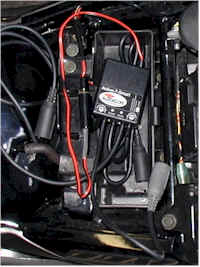 Most sport bikes have plenty of room under the seat for the Autocom unit. On this Kawasaki ZZR-1200 the tool kit was removed to mount the Active-7. You can easily see the coaxial power connector to the left of the unit which allows quick removal from the bike. |
All testing to this point was done under conservative, legal riding conditions. While many riders are responsible cyclists most of the time, a recognizable percentage of us do like to twist the throttle a little harder than we should from time to time. I've got a second Harley that has a more aggressive exhaust note than many other motorcycles. This would be the true test on how well Autocom systems work under extreme conditions. I went for a very spirited ride on this bike after moving one of the units to this bike. While cruising speeds well above legal limits did not effect the system, it was almost immediately obvious that the Autocom VOX unit was having trouble with the sound level of this bike under heavy acceleration. The VOX would key the mike anytime the accelerator was twisted more than 50-60%. Adjusting the VOX setting to the 180MPH level did not eliminate this issue.
The less than optimum performance of the Autocom unit on the Harley under full throttle shook my faith in the ability of the Active-7 to handle "any bike, any speed". More full throttle testing was required on my sport bike. Since I had placed the coax power connectors on each bike, moving the unit from the HD to the ZZR1200 took less than 5 minutes. Out on the road with the ZZR I tried some full throttle acceleration runs in the lower gears. The engine and exhaust noise associated with accelerating to triple digit speed did not cause the VOX to key the microphone. There was no attempt at making top speed runs to test the limits of the units. I'm very proud of the fact that I have no points on my Drivers License and plan to keep it that way.
The Ugly? NO! Just the Unexpected.
To be fair to Autocom and ensure I didn't do anything wrong, I e-mailed the
USA Distributor and UK Corporate technical support sites describing what I had
found and noted that there was going to be a published review of the Active-7
unit. In both cases I got a response asking me to verify the VOX settings I had
used on the motorcycle. I sent my answers back to them on the same day
explaining that I had properly adjusted the VOX, asking for additional guidance
on resolving this issue. While the second responses from Autocom took over 24
hours, they did get back to me. Autocom America actually called me about my
issue with the unit.
| On Harley-Davidson's and most other cruisers, a surprising portion of noise actually emanates from the intake tract and valve train. The use of high flow air cleaners and performance camshafts raise the sound level of an engine significantly. Now consider the fact that the rider's head is usually sitting just over the rear cylinder, with little to block the sound. Strange as it may seem, much of what the rider hears while riding comes from this area and not the exhaust. |
I spent some time on the phone with Autocom America discussion the particular
issue with the VOX "keying" under full throttle. We agreed that a
"wind sock" on the microphone should help reduce this issue. But after
discussing some of the technical details of the way the VOX works, there was
some speculation on why the issues was occurring. The electronics of the VOX are
tuned to recognize the frequencies of a human voice. The combination of the
location of the noise from the HD valve train just below the rider's helmet and
the specific frequencies that these sounds produce probably contribute to the
situation of the VOX keying. The situation I noted probably has nothing to do
with noise from the exhaust system. As a point of interest, the difference in
exhaust sound levels at moderate throttle openings between my HD and ZZR-1200
does not seem to be much different when listened to from a distance.
I presented Autocom an absolute worst case situation and while exposing some
chinks in the shiny armor and good reputation this Company has earned, I never
felt like the unit was sub-par. As a matter of fact, my past experience in
trying to find ways to communicate between two Harley's has only convinced me on
how good the Autocom units really are.
What about Radios?
Unless buying your Autocom unit and 2-way radios from the same source, it is
highly recommended that you or your Dealer contact Autocom directly to ensure
you get the proper adapter cable for your radios. This will save a lot of
frustration for you and the local Dealer caused from trying to use wrong cables.
It took me a while to get the correct wiring adapter to connect the units to
some Motorola FRS/GMRS radios because of this very reason. We ordered without
verifying connectivity.
Once the proper cables were available, our radios integrated into the Autocom electronics without issue. As anticipated, the radios worked as well as the cell phones for clarity of bike-to-bike communications. It might take you a while to get used to the rapid VOX reaction on the Autocom. This is very good when you start to talk because the person at the other end does not miss any of your speech. It could be bothersome because the VOX will "un-key" the mike almost as fast, cutting you off in mid sentence if you talk slow. You may want to revert to the old fashioned "Over" statement when you are finished talking. A simple but effective solution.
Testing Summary
While no scientific methods were used, our testing of the Autocom unit was methodical and quite extensive. We created a wide variety of situations that ranged from simple functionality testing to riding situations that anyone was likely to encounter.
| Test Number |
From | To | Radio | Cell Phone |
Music | Riding Style | Notes | Results |
| 1 | Sport Bike | Phone | X | Sitting Still | No Problems | OK | ||
| 2 | Sport Bike | Phone | X | Normal Riding | Adjusted VOX | OK | ||
| 3 | Sport Bike | Harley | X | Normal Riding | Adjusted Volume | OK | ||
| 4 | Harley | Phone | X | Very Spirited | VOX keys mike under heavy throttle | Only usable if PTT added | ||
| 5 | Sport Bike | Phone | X | Very Spirited | Sometimes wind noise would key mike | OK | ||
| 6 | Sport Bike | Phone | X | X | Spirited | Listen to FM Radio | OK | |
| 7 | Sport Bike | GMRS Radio | X | Sitting Still | Wind Sock in place No Problems |
OK | ||
| 8 | Sport Bike | Harley | X | Normal Riding | Wind Sock in place No Problems |
OK | ||
| 9 | Harley | Harley | X | Normal Riding | Wind | OK | ||
| 10 | Harley | Harley | X | Spirited | Wind Sock in place No Problems |
OK | ||
| 11 | Sport Bike | Harley | X | X | X | Normal Riding | Wind Sock in place Occasional "muting" of cell phone calls with radio in place |
OK |
| 12 | Harley | Harley | X | Very Spirited | Wind Sock in place Wide Open Throttle No VOX mike key under full throttle |
OK |
The Bottom Line
| Autocom makes a Wind Sock kit (Part 43) for the microphone that is normally used for open face helmets. The small cost of this kit should help reduce any inadvertent wind noise keying the mike with a full face helmet. This is well worth the extra $5 |
| Since I wrote my original review, I had the chance to do some testing at higher than "street speeds" on the ZZR-1200. We won't mention that the speeds were over 2x legal US limits. The air flow over the windshield results in a lot of wind noise when you look down while riding. This can result in "keying" of the microphone under a lot of normal riding conditions (like checking your mirrors or looking at instruments) unless you turn the VOX setting to a higher than normal setting. The higher the VOX setting, the harder it is for the person at the other end of your communication channel to understand you. The effect noted actually shows up at highway speeds. As long as you are in a "heads up" riding mode, you'd probably never notice the situation. As soon as you relax and your head/eyes start wandering around the VOX keying showed up. The effect is purely due to wind coming up from under the helmet. Simply placing your across the bottom of your helmet eliminate the issue, so helmets with a wind block may not have the issue. I did the testing on my Shoei RF-900. While there are some bikes and helmets that might not have the same air flow up past your face, I suspect that my experience is going to be fairly typical. |
Autocom makes an excellent motorcycle communication device that works very
well under a wide variety of circumstances. From the least expensive Easy Rider,
to the middle priced Active-7, or the top of the line Pro Rider, you can
purchase the communication capabilities you need. The flexibility of these units
goes way beyond bike-to-bike communications, rider-to-passenger intercom and
music input. Because you have your choice of radios, you could use CB, FRS,
GMRS, VHF or UHF radios. You can also use your cell phone or walkie-talkie style
cell phone. Then you can add music in the form of a radio, CD or MP3.
You can also wire in your radar detector and GPS. While I didn't get a chance to
test these last two capabilities, they should work within the established
limits.
Any Bike, Any Speed?
For a while it looked like "Any Bike" might be inaccurate. Certain circumstances did overwhelm the VOX in our testing. A highly modified, big engine V-twin cruiser with an after-market exhaust did outstrip the VOX capability of the Autocom unit while the bike was accelerating hard. Installation of the Wind Sock Kit did eliminate this minor issue on these very noisy motorcycles. We never experienced the VOX keying issue while testing on the sport bike. Essentially the Autocom unit handled every condition thrown at it.
While we never attempted any maximum speed testing, there is little doubt in my mind that you can ride well above any legal USA speed limit and be able to carry on a normal conversation with a rider on another bike or talk with someone on their cell phone.
Summary
Being able to ride and talk with other riders while in motion, or listen to
music adds a completely new dimension to your riding. You should consider
Autocom if you are looking for communications quality, reliability and
flexibility for your motorcycle. You will be hard pressed to find better
capabilities than the Autocom units offer.
For more information see:
http://www.autocom.co.uk
http://www.autocomamerica.com
|
|
Disclaimer
In some states the use of headphones and listening to music while riding may be against the law. Please check your state DMV for applicable laws. Does a set of "speakers" located in your helmet qualify as "headphones"? Only a court of law can determine this question. The author does not endorse or support any activity that may result in an impairment of a riders ability to navigate the roads safely or may be in violation of state/federal laws. |
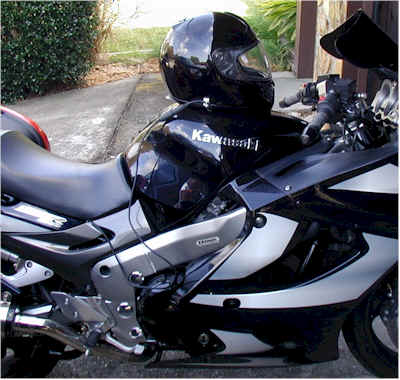 Here is the completed installation on the ZZR-1200. Cell phone, radio and music sources can all be located under the seat, or you can install mounts to the steering or instrument panel for more accessibility. |
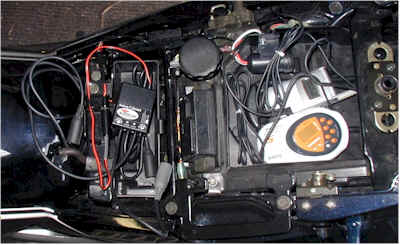 The Autocom Active-7 unit was mounted in the took kit area, leaving plenty of room under the seat for a cell phone and music source. There is still enough room to place a GMRS/FRS radio. The advantage of this under seat location for everything is improved weather protection. |
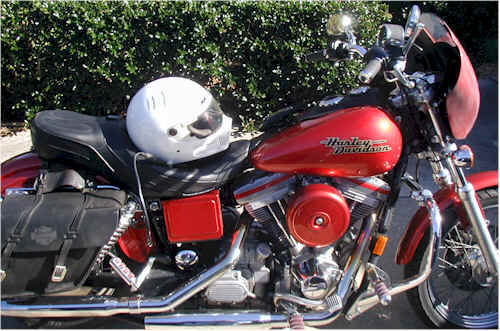 The Autocom unit is neatly tucked away under the seat on this HD Dyna Super Glide. Wiring is routed out near the ignition switch. A Motorola GMRS radio is shown clipped to a mount on the dash panel, just in front of the seat. You could also wear your electronics on your belt or put them in the saddlebags. For this installation, the cell phone and music connectors are routed into the saddle bags. |
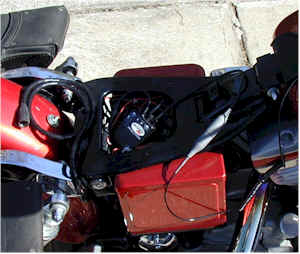 There is plenty of room for the Autocom Active-7 unit to be placed under the seat of this Harley-Davidson FXD. You can see the helmet connector to the left of the unit and the radio connector to the right. |
| Copyright 1997-2006 Stephen Mullen, Oldsmar, FL -+- |